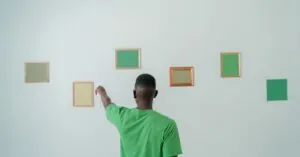Tired of stepping on rogue LEGO bricks or playing hide-and-seek with misplaced action figures? It’s time to reclaim your living space with DIY toy storage bins that are as stylish as they are functional. Who knew organizing could be this fun? With a little creativity and some elbow grease, anyone can transform clutter into a masterpiece that even the kids will love.
Table of Contents
ToggleWhat Are DIY Toy Storage Bins?
DIY toy storage bins serve as customized solutions for organizing children’s toys. These bins can be crafted from various materials, including wood, fabric, or recycled containers. Parents can design them to match their home decor while catering to the specific needs of their children.
Functionality plays a significant role in the design of DIY toy storage bins. They can include features like labels for easy identification of contents or handles for convenient transportation. Bins come in different sizes to accommodate small items such as action figures or large toys like stuffed animals.
Creativity thrives when constructing these storage solutions. Parents often involve their children in the process, letting them choose colors or patterns, which creates a fun activity that also teaches organization skills. Personalization adds a unique touch, making each bin a reflection of the child’s personality.
Styles vary widely, from minimalist wooden crates to colorful fabric baskets. They can be stacked or placed on shelves, maximizing space and promoting a tidy environment. Some parents even repurpose old furniture to create eye-catching storage solutions that add character to a child’s play area.
Overall, DIY toy storage bins combine practicality and aesthetics. They provide children with a designated place for toys, reducing clutter in living spaces. Engaging in this project fosters responsibility among children, teaching them to care for their belongings while enhancing the home’s visual appeal.
Benefits of DIY Toy Storage Bins
DIY toy storage bins offer numerous advantages that enhance home organization and child development. These bins provide practical solutions for managing toys effectively while adding aesthetic value to living spaces.
Cost-Effectiveness
Creating DIY storage bins saves money compared to purchasing ready-made storage solutions. Materials for these projects can often be sourced from recycled containers or affordable supplies. Parents can budget effectively while addressing their storage needs without sacrificing quality. Savings can accumulate by using old furniture or upcycling items, allowing families to invest in other essentials. Moreover, DIY projects often yield more storage space than standard options, resulting in long-term economical benefits.
Customization Options
Customization makes DIY toy storage bins appealing to families. Parents can design bins that match their home decor, ensuring cohesive aesthetics. Color choices, patterns, and shapes can reflect children’s personalities. Different materials, like wood or fabric, offer diverse textures and styles that suit any room. Involving children in the design process fosters creativity and ownership over their space. Personalization allows bins to cater to specific toy types, enhancing organization and accessibility. Families gain functional pieces that align with their values and tastes by choosing details.
Materials Needed for DIY Toy Storage Bins
Creating DIY toy storage bins requires specific materials and tools that enhance both functionality and aesthetics. Selecting the right components ensures a durable and visually appealing end product.
Choosing the Right Materials
Wood, fabric, and plastic containers serve as excellent choices for building toy storage solutions. Wooden crates offer sturdiness and a rustic touch. Fabric baskets come in various colors, making them a fun option for children. Recycled containers provide an eco-friendly alternative that promotes sustainability. Consider the style and purpose of the bins, since materials should complement the existing home decor. When making decisions, prioritize safety by choosing non-toxic finishes and sturdy components.
Essential Tools for Building
Gathering tools simplifies the DIY process and ensures accuracy during construction. A measuring tape helps with precise dimensions, while a saw is necessary for cutting wood to size. Sandpaper smooths edges, creating a polished finish. Use a paintbrush for applying finishes and a durable adhesive for assembly. Incorporate screws and a screwdriver to secure components firmly. A level guarantees that each bin is balanced. Invest in these tools for a successful DIY project that provides long-lasting toy storage solutions.
Step-by-Step Guide to Creating DIY Toy Storage Bins
Creating DIY toy storage bins involves careful planning and execution. Each step contributes to a successful project that can simplify toy organization.
Planning Your Design
Start by assessing the available space for the bins. Choosing the right size helps maximize storage efficiency. Select shapes and colors that complement the room’s decor. Involving children in this phase encourages creativity and ownership. sketch the design to visualize the final look. Consider adding personalization, such as names or themed graphics. This makes the bins fun and appealing. Decide on the materials that align with your budget and aesthetic preference. Ensure safety by opting for non-toxic finishes. Ultimately, a well-thought-out design caters to both functionality and visual appeal.
Constructing the Bins
Gather all necessary materials and tools before starting. Measuring accurately guarantees a precise fit. Cut wood or fabric based on the planned design. Assemble pieces using durable adhesives or screws for stability. Sand edges to prevent splinters and ensure a smooth finish. If using fabric, consider sewing or stapling for secure joining. Create lids or covers if desired, providing additional protection for the toys. Label each bin for easy identification, promoting organization. Attach handles on fabric or wooden bins for effortless transportation. A systematic approach results in sturdy bins that enhance any play area.
Tips for Organizing Toys with Storage Bins
Using toy storage bins effectively can significantly minimize clutter. Start by categorizing toys into groups, such as building blocks, stuffed animals, and art supplies. Grouping makes it easier to store items and access them when needed.
Labeling each bin simplifies locating specific toys. Clear labels allow children to identify where toys belong, encouraging them to participate in clean-up activities. Consider using colorful labels or pictures to make identification fun for kids.
Incorporating bins of varying sizes maximizes space in play areas. Smaller bins work well for tiny items like action figures, while larger bins accommodate bigger toys. Each bin’s size should correspond to the specific type of toys stored within.
Using aesthetically pleasing designs can enhance overall decor. Customized bins matching home aesthetics appeal to both parents and children. Selecting bins with fun colors or themes creates an inviting play environment.
Utilizing vertical space often creates additional storage options. Wall-mounted bins or shelves can hold toys while keeping play areas organized. This strategy optimizes floor space, making rooms appear larger and tidier.
Encouraging children to participate in the sorting and organizing process fosters responsibility. Allowing kids to choose colors or themes for their bins makes the process engaging. Creativity in designing their storage solution empowers them to take ownership of their play areas.
Regularly reviewing and reorganizing toy storage ensures it remains functional. Assessing the contents of bins every few months allows for the removal of unused toys. This practice prevents clutter from accumulating and sustains an organized space.
Creating DIY toy storage bins not only tackles the issue of clutter but also adds a personal touch to any play area. By customizing these bins, parents can combine functionality with style while teaching children valuable organizational skills.
Involving kids in the design process makes it a fun and engaging activity that fosters creativity. The satisfaction of building something together enhances family bonds and instills a sense of responsibility in children.
With a variety of materials and designs available, DIY toy storage bins can seamlessly fit into any home decor. By implementing these creative solutions, families can enjoy a tidier living space while encouraging children to take ownership of their toys.




